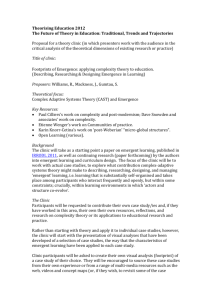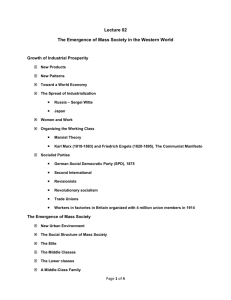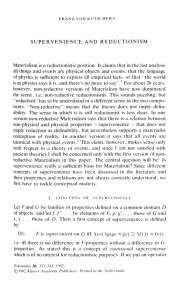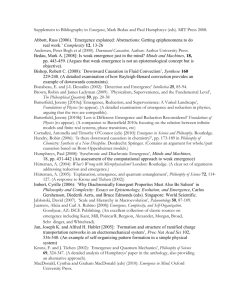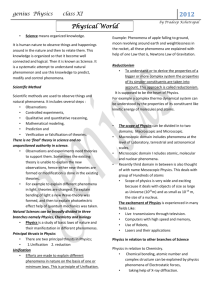Emergence, Not Supervenience
advertisement
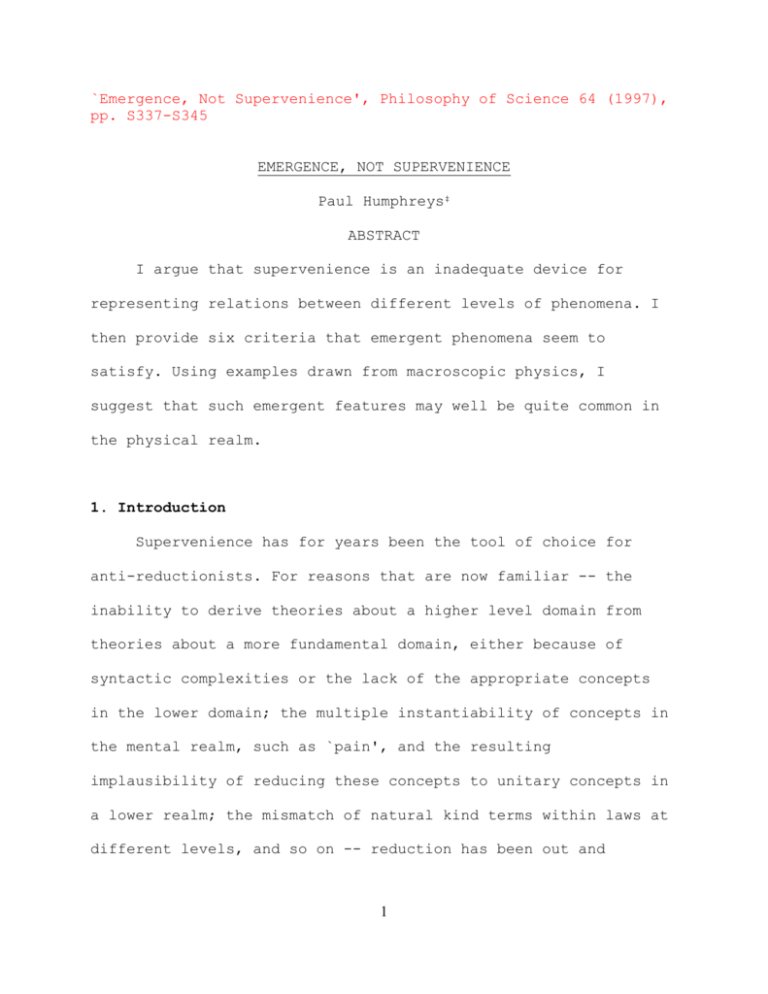
`Emergence, Not Supervenience', Philosophy of Science 64 (1997), pp. S337-S345 EMERGENCE, NOT SUPERVENIENCE Paul Humphreys‡ ABSTRACT I argue that supervenience is an inadequate device for representing relations between different levels of phenomena. I then provide six criteria that emergent phenomena seem to satisfy. Using examples drawn from macroscopic physics, I suggest that such emergent features may well be quite common in the physical realm. 1. Introduction Supervenience has for years been the tool of choice for anti-reductionists. For reasons that are now familiar -- the inability to derive theories about a higher level domain from theories about a more fundamental domain, either because of syntactic complexities or the lack of the appropriate concepts in the lower domain; the multiple instantiability of concepts in the mental realm, such as `pain', and the resulting implausibility of reducing these concepts to unitary concepts in a lower realm; the mismatch of natural kind terms within laws at different levels, and so on -- reduction has been out and 1 supervenience has been in. This position is only half right. Reduction is still not an option, but supervenience is no good either. It is a notion that ______________________________________________________________ ‡Corcoran Department of Philosophy, 521 Cabell Hall, University of Virginia, Charlottesville, VA 22903, USA. pwh2a@virginia.edu is empty of any scientific content, and what antireductionistsneed in its place is emergence. The latter idea can properly capture the picture of distinctively different layers of the world in which anti-reductionists believe. As always, there is a price to pay for adopting an emergentist view. In certain cases one must give up a number of metaphysical views that, for good or ill, have proven attractive to many. One of these is ontological minimalism. Ontological minimalism runs roughly like this: a) There is a relatively small set of fundamental constituents of the world, b) to individuate these we need only intrinsic (i.e. nonrelational) properties, and c) all the non-fundamental individuals and properties are composed of or from these fundamental entities. Ontological minimalism is an attractive view. Indeed, if one accepts a well-known set of philosophical doctrines, it comes out almost right. Chief amongst these 2 doctrines are 1) Giving primacy to logical reconstructions of ordinary and scientific concepts, and 2) a broadly Humean account of causal relations. If, in contrast, one thinks that these two doctrines (and related ideas) are wrong, then ontological minimalism will seem to be a perverse misrepresentation of the way our world happens to be. This is not the place to argue in detail against those two doctrines (arguments for their rejection can be found in my (1995) and (1997a)1). Suppose that one did accept the rough picture provided by these two doctrines (which I do not). Then the core belief that underlies ontological minimalism is that non-fundamental entities are nothing but collections of fundamental entities. What is important for present purposes is that ontological minimalists commonly interpret the `nothing but' as either `aggregate' or `supervenient upon'.2 2. Supervenience In his paper "Emergence as Non-Aggregativity" William Wimsatt (1998) has demonstrated beyond any doubt that aggregativity is a hopelessly inadequate approach to almost any composite object to which it has been applied. Here I shall try to show that supervenience is similarly inadequate, albeit in a different way. Despite the fact that many supervenience accounts are non- 3 reductive in intent, there is a strong residue of suspiciously reductionist terminology within many of them. There is the `If A supervenes upon B, then A is nothing but B,' talk of course. In addition, there is the idea that if A supervenes upon B, then because A's existence is necessitated by B's existence, all that we need in terms of ontology is B.3 This is a core belief that motivates physicalism -- all one needs is the ontology of physical objects and properties, then everything else supervenes upon those. From the plethora of definitions of supervenience that have been offered I shall take as representative that of strong supervenience, which seems to be the most widely accepted. My criticisms will apply, mutatis mutandis, to weak and global supervenience. One standard definition of strong supervenience is this: Definition: A family of properties M strongly supervenes on a family N of properties iff, necessarily, for each x and each property F in M, if F(x) then there is a property G in N such that G(x) and necessarily if any y has G it has F. (Kim 1993, 65) Such definitions have little content until the kind of necessitation involved has been given. So let us consider nomological necessity and logical (or metaphysical) necessity 4 (for both operators) as natural interpretations of the modal operators.4 Supervenience, as its name implies, is standardly taken to be a relation between two collections of properties, one at a higher level than the other. Yet there is nothing in the definition itself that requires the relation to hold only between different levels, and this raises an interesting question: why is supervenience taken to be revealing as an inter-level relation but has no significant applications as an intra-level relation? Or, to put it another way, in what way, if at all, does the existence of a supervenience relation between two sets of properties explain why the members of the supervening set have an inferior ontological status than do the members of the subvening set? (And have no doubt that they carry an inferior status, for how else could physicalism have the appeal that it does if physical states were not the only legitimate ontology?) To see why this is a problem, let us, as it were, turn the supervenience relation on its side and apply it within a given level. First, consider the causal relation. Let M be a set of `effect properties', and N be a set of `causal properties' i.e., M consists in properties, instances of which are characteristically found as effects of instances of properties in N. For a simple example, take M as expansion in 5 volume, and N as properties that cause expansion, such as heat, increase in pressure, and so on. Then, with the first interpretation of the necessities in the definition as nomological necessities, it is easily seen that in every possible world with the same laws as ours, if something expands, then there is some other property such as heat that applies to that thing and this nomologically necessitates its expansion. Now, no one will agree that expansion is `nothing but' application of heat. Why not? One plausible explanation is that both heat and expansion are already considered to be respectable physical properties, and so there is no need to bring in supervenience to (putting it slightly pejoratively) `explain away' the supervenient properties. A second, but quite different, interpretation of supervenience, to the effect that the supervening properties are real, but have some secondary sort of status that is necessarily dependent upon their subvenient properties5, does not seem very promising either, because both heat and expansion are ordinarily taken to be equally real. Caveat: supervenience is concerned with the dependence of one set of properties upon another. In the expansion case, it is indisputable that an instance of expansion is nomologically dependent upon (an instance of) application of heat but this is 6 not the issue under discussion here; it is whether the properties themselves are so dependent. Of course, one already knows what the difference is between the inter-level and the intra-level applications of supervenience. In the case of interlevel applications, the inferior status of the supervening properties is nothing more than their initially having been considered to be less respectable than their subvenient bases, which is why the supervenience relation was constructed in the first place. Yet this clearly reveals that whatever the supervenience relation does, it does not, in itself, answer our question.That is, there is nothing in the nature of the supervenience relation itself that will explain why 'vertical' uses are appropriate and 'horizontal' uses are not. Take a second case, one involving logical or metaphysical necessitation. Here let M be the set consisting only of the property `is triangular' and N the set consisting only of the properties `closed', `three-sided', `Euclidean' and `polygon'. Then it is again obvious that M supervenes upon N. To say that M is nothing but N will not concern you if you subscribe to the position that metaphysically equivalent properties are identical. Although some philosophers have accepted this, many have found it to be quite implausible, and those of us who reject it in doing so also reject the idea that the property of 7 being triangular has some sort of secondary, dependent, status. It thus seems that there is something wrong with applying supervenience relations within ontological levels, and the reason why is pretty clear. In both of the examples I have described, we have good reason to hold that the supervenient property has some independent standing, irrespective of the fact that there are necessitation relations holding between it and other properties. With inter-level applications of supervenience, I doubt that anyone holds that the existence of a supervenience relation is itself a reason for ascribing some sort of secondary status to the supervenient property -- this is already assumed. Mental properties, aesthetic properties, moral properties are antecedently taken to be less desirable than physical properties. So the question that remains is this: what is it that makes the supervenience relation admissible as an inter-level relation, but renders it wrong-headed as an intralevel relation? It cannot be simply a prejudice in favor of physical properties, for that would not explain why it gives unacceptable answers for geometrical properties. I believe that the answer is this: supervenience is acceptable as a consistency condition on the attribution of concepts, in that if A supervenes upon B, you cannot attribute B to an individual and withhold A from it. If aesthetic merit supervenes upon just 8 spatial arrangements of color on a surface, and you attribute beauty to the Mona Lisa, you cannot withhold that aesthetic judgement from a perfect forgery of the Leonardo painting. But supervenience does not provide any understanding of ontological relationships holding between levels. For that emergence is required. 3. Possible Criteria for Emergence Perhaps the most characteristic feature of emergent properties is that they are novel. Novelty can mean many things, but the simplest and crudest interpretation is that a previously uninstantiated property comes to have an instance.6 Clearly, it is important how this novel instance came about. If the new value of, say, mass comes about by mere rearrangement of existing matter (by aggregating bits of smaller mass, or slicing up a larger mass) then we say that the 'novel' property instance was there all along, it just was not instanced by the object that now has it. (In the aggregate case, it was a collection of spatially separated objects that had the 'new' mass; in the slicing case, then it was a part of the object that had it). The novelty criterion for emergence would then be violated, and so this turns out to be no case of emergence at all. Suppose in contrast that the new mass value occurred spontaneously (from nothing), or was the result of (spontaneous) conversion of 9 energy to mass. Here there is more of a sense of novelty, emergence from something else or from nothing. But this is a boring kind of emergence, and not the kind of case in which we are interested, for what we want from emergence is not a new value of an existing property, but a novel kind of property. This then gives us the second characteristic feature of emergent properties, which is that they are qualitatively different from the properties from which they emerge. Four other features of emergent properties suggest themselves. The third is that an emergent property is one that could not be possessed at a lower level -- it is logically or nomologically impossible for this to occur. The fourth is that different laws apply to emergent features than to the features from which they emerge. This anti-reductionist view has been suggested by the physicist P.W. Anderson: "Reductionism is the thesis that all of the animate and inanimate matter of which we have any detailed knowledge is assumed to be controlled by the same set of fundamental laws..." (Anderson 1972, 393)) We should then have that entities of type B are emergent from entities of type A iff entities of type B have type A entities as constituents and there is at least one law that applies to type B entities that does not apply to type A entities. The fifth characteristic feature of emergent properties is 10 that they result from an essential interaction between their constituent properties, an interaction that is nomologically necessary for the existence of the emergent property. This is one sense that gives us the novelty -- before the property instances interacted there never had been an instance of the new property. We might want to add that the property isntance occurs at a higher level, or that the property instance is attached to a new kind of entity. That is, a hydrogen atom is an emergent entity - it is not just an electron and a proton put in a new spatial arrangement, but there is an essential interaction between them. And the sixth feature is that emergent properties are holistic in the sense of being properties of the entire system rather than local properties of its constituents. A non-relational property of a whole is emergent if it supervenes upon but does not reduce to the non-relational properties of its parts.(Teller, p.142) <tie in with internal relations> 4. Some Examples I do not suggest that any emergent phenomenon must satisfy all of these criteria, for there is a wide variety of ways in which emergence can occur. In my (1997), I provide an account of one kind of emergence in terms of so-called `fusion' operations, 11 and it turns out that it fits the most widely canvassed examples of emergence, those involving quantum entanglements. This sort of emergence directly satisfies our fifth and sixth criteria above, and when it is the basis for macroscopic phenomena such as superconductivity and superfluidity, it will satisfy at least criteria one, two, and four as well.7 In fact, we can look to macroscopic phenomena for examples of other kinds of emergence too. The idea that emergence can involve a qualitative difference in properties even though the object possessing those properties is composed from more elementary objects occurs in what is known as the theory of macroscopic systems. A macroscopic system can be defined as one whose equation of state is independent of its size (Sewell 1986, 4). An ideal macroscopic system is one containing an infinite number of particles, the density of which is finite. A real macroscopic system is one that is sufficiently large that its equation of state is empirically indistinguishable from an ideal macroscopic system (see Sewell 1986, 4). These definitions are purely objective and do not rely on a characterization of `macroscopic' by way of reference to human observers. One of the principal features of macroscopic systems in that sense is that they display qualitatively different properties than do the 12 microcomponents that compose them and that they are holistic. They thus satisfy our second and sixth criteria above. To illustrate this, here is a typical quotation: 13 Macroscopic systems enjoy properties that are qualitatively different from those of atoms and molecules, despite the fact that they are composed of the same basic constituents, namely nuclei and electrons. For example, they exhibit phenomena such as phase transitions, dissipative processes, and even biological growth, that do not occur in the atomic world. Evidently, such phenomena must be, in some sense, collective, in that they involve the cooperation of enormous numbers of particles: for otherwise the properties of macroscopic systems would essentially reduce to those of independent atoms and molecules. (Sewell 1986, 3) 14 Also: 15 The quantum theory of macroscopic systems is designed to provide a model relating the bulk properties of matter to the microscopic ones of its constituent particles. Since such a model must possess the structure needed to accommodate a description of collective phenomena, characteristic of macroscopic systems only, it is evident that it must contain concepts that are qualitatively different from those of atomic physics. (Sewell, 1986, 3) 16 This kind of talk is reminiscent of Rohrlich's conceptual irreducibility (Rohrlich 1997)8, the main point being that the emergent properties cannot be possessed by individuals at the lower level because they occur only with infinite collections of constituents. Some of the most important cases of macroscopic phenomena are phase transitions, such as the transition from liquid to solid. This transition is not exhibited by the microcomponents of the liquid (or the solid) since the individual components are the same in each phase. It is their collective relationship to each other that changes across the (usually discontinuous) phase transition. Thus, it is the interactions between the constituents that makes for the qualitatively different macroscopic behavior. An example of this kind of interactive behavior is the spontaneous ferromagnetism that occurs below the Curie temperature, which is absent above that phase transition point and which occurs because of spin interaction coupling between adjacent particles on the lattice. It might appear that such cases are no different from more familiar ones, wherein the properties of water molecules, say, are different from the properties of the hydrogen and oxygen atoms that compose them. Essentially macroscopic phenomena are different from these, however, as the 17 following example shows. There are many qualitatively distinct macroscopic phenomena associated with ferromagnets and similar systems, but one will suffice here. If one takes a ferromagnet whose Hamiltonian is spherically symmetric, then below the Curie temperature the system is magnetized in a particular direction, even though because of the spherically symmetric Hamiltonian, its energy is independent of that specific direction. This divergence between the symmetry exhibited by the overall system and the symmetry exhibited by the laws governing its evolution is an example of spontaneous symmetry breaking. We have here a case where there is a distinctively different law covering the N -> system than covers its individual constituents. This is exactly the kind of difference of laws across levels of analysis that we noted earlier as one criterion of a genuinely emergent phenomenon. It is important to emphasize the qualitatively different nature of these macroscopic phenomena, because it is not simply a result of our inability to provide an explicit Schrödinger equation for the macroscopic system (let alone solve it). It is a consequence of considering the macroscopic system as a system composed of an infinite number of particles, with boundary conditions that are macroscopic in form. This means that the system is necessarily nonmicroscopic, in that it is inconsistent 18 to consider a collection of infinitely many particles in conceptually the same way as an atomistic component, which is essentially singular. These sorts of examples are persuasive, but they do of course rely on idealized models of real systems. That is in the nature of the examples and should not count against them as examples showing that emergent phenomena are not inescapably mysterious, are perhaps common, occur within indisputably physical systems rather than just biological or psychological systems, and can be given a treatment that is far more detailed than any supervenience account can even approach. 5. Conclusion I believe that the arguments given here reveal three things. First, that emergent properties are probably quite common in the physical realm. If this is true, it will be likely that there will be no sharp boundary between the physical level and other levels. In turn, this will require refinement in terms of what we mean by physicalism, and in our reasons for holding it. Secondly, that the existence of these detailed models at the physical level dissolve the air of mystery that has traditionally surrounded emergentism and has led clear-headed philosophers to stay away. Finally, that the level of detail available in these models makes the use of supervenience 19 relations seem simplistic. And it is for these three reasons at least that we need emergence, not supervenience. REFERENCES Anderson, P.W. (1972):"More is Different", Science 177: 393-396. Armstrong, D.M. (1989): Universals: An Opinionated Introduction. Boulder: Westview Press. Humphreys, P.W. (1995), "Understanding in the Not-So-Special Sciences", Southern Journal of Philosophy XXXIV, Supplement: Spindel Conference 1995:99-114 _______________ (1997), 'How Properties Emerge', Philosophy of Science 64: 53-70 20 ____________ (1997a), "Aspects of Emergence", Philosophical Topics 24: forthcoming. Kim, J. (1993), Supervenience and Mind. Cambridge: Cambridge University Press. Lewis, D.K.(1986), On the Plurality of Worlds. Oxford: Blackwell. Rohrlich, F. (1997), `Cognitive Emergence', Philosophy of Science 64 (Proceedings): This issue. Rosenberg, A. (1997), `Can Physicalist Antireductionism Compute the Embryo?', Philosophy of Science 64 (Proceedings): This issue. Sewell, G.L. (1986), Quantum Theory of Collective Phenomena. Oxford, The Clarendon Press. Teller, P. (1992), `A Contemporary Look at Emergence', in A Beckermann, H. Flohr, and J. Kim (eds), Emergence or Reduction?, Berlin: Walter de Gruyter, 139-153. Wimsatt, W. (1998): Emergence as Non-Aggregativity and the Biases of Reductionisms", in W. Wimsatt, Piecewise Approximations to Reality. Cambridge: Harvard University Press: forthcoming. 21 FOOTNOTES 22 1I am here accepting only for expository purposes the idea that there exist distinct levels of individuals and properties. Since most advocates of supervenience believe in this sort of layered ontology, it would be a distraction to deny it here. So, for example, I here go along with the view that atoms occupy a lower level than do simple inorganic molecules, which in turn occupy a lower level than do complex organic molecules. These strata then provide a separation between properties of atoms, simple inorganic molecules, and complex organic molecules. Arguments against the levels view can be found in Humphreys (1995) and (1997a) 2.Interpretations of 'A supervenes on B' as 'A is nothing but B' can be found (in so many words) in Armstrong (1989, 56):"...if it supervenes, I suggest, it is not distinct from what it supervenes upon", and in Lewis (1986, 14):"...all there is to the picture is dots and non-dots at each point of the matrix. The global properties are nothing but patterns in the dots."; "Symmetry is nothing but a pattern in the arrangement of dots" (Lewis 1986, 15). See also Rosenberg (1997) for similar sentiments about reduction. 3.Again, Armstrong (1989, 100):"The relation supervenes upon the terms...That, I think, makes the relation an ontological free lunch." 4.In the discussion after the symposium, Andrew Melnyk suggested that some form of necessitation other than nomological or metaphysical might well be appropriate for supervenience relations. There was not enough time before submitting this paper to explore this option. 5.This is the interpretation that seems to be favored by Kim throughout much of his (1993), although he now seems to have doubts about the tenability of various supervenience views. 23 6This sort of case is canvassed, and rejected in Teller (1992). 7Whether it satisfies the third criterion depends upon how the levels are determined, something I have put aside here. 8.Although I find Rohrlich's conception of emergence too psychological for my taste. 24

